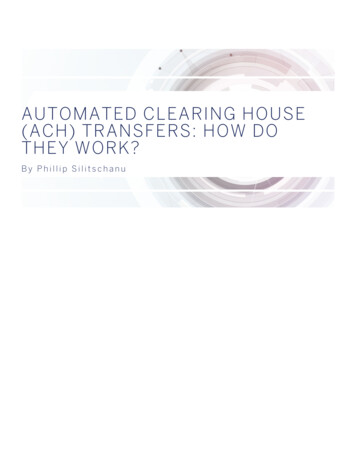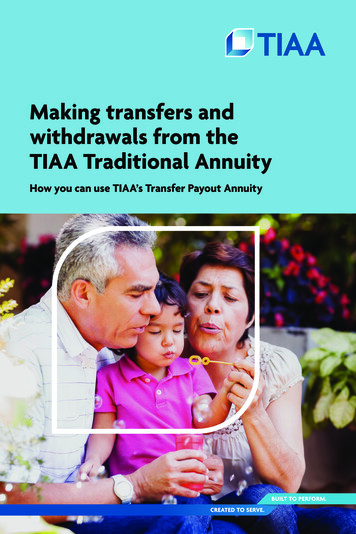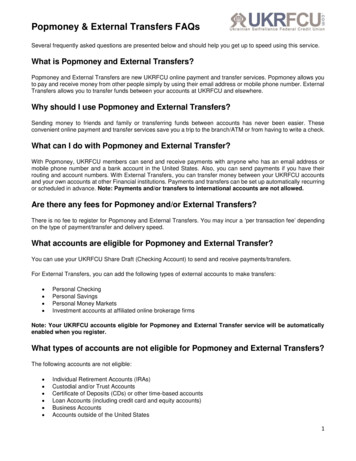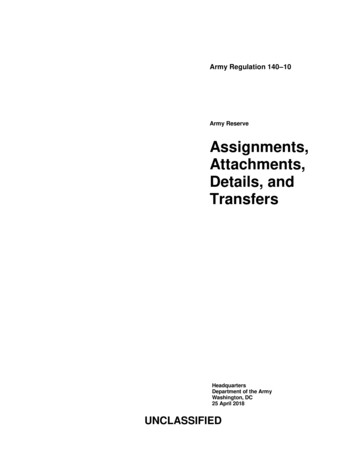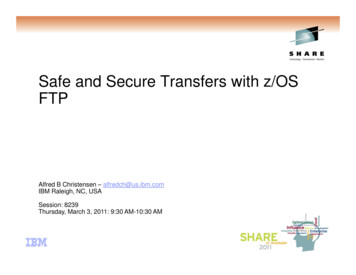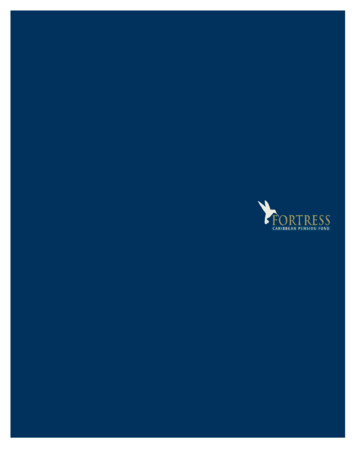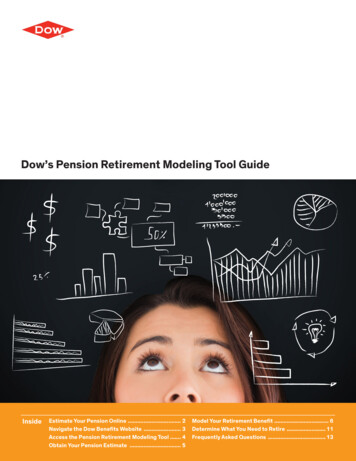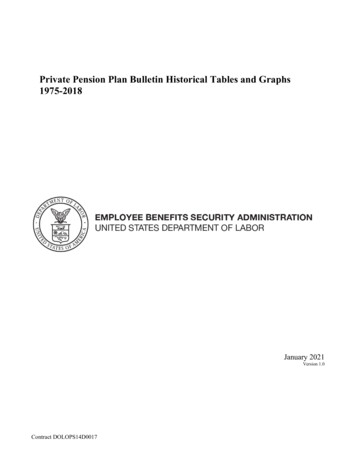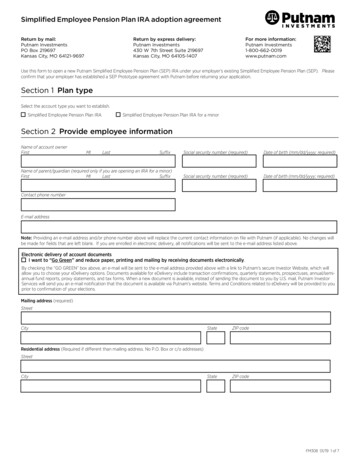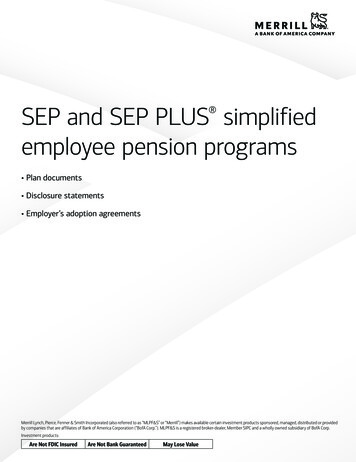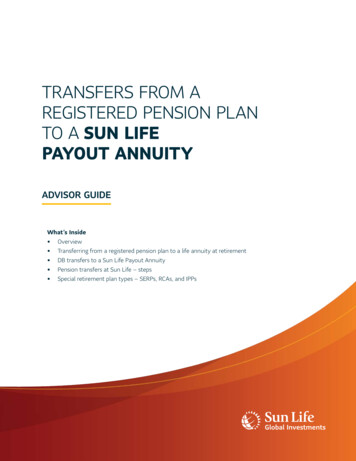
Transcription
TRANSFERS FROM AREGISTERED PENSION PLANTO A SUN LIFEPAYOUT ANNUITYADVISOR GUIDEWhat’s Inside Overview Transferring from a registered pension plan to a life annuity at retirement DB transfers to a Sun Life Payout Annuity Pension transfers at Sun Life – steps Special retirement plan types – SERPs, RCAs, and IPPs
A guide to understanding transfers from aregistered pension plan to a life annuityThe purpose of this guide is to help advisors understand the transfer of registered pension plan assets to alife annuity in general and, specifically, to a Sun Life Payout Annuity. It will cover the basic differences betweendefined contribution (DC) and defined benefit (DB) plans with a focus on how those differences impact thetransfer opportunity as outlined below.DC plan transfers: Transfers to life annuities are very common. Generally, there are few tax issues. Determining Client suitability is a relatively straightforward process.DB plan transfers: There are potential tax implications to consider. Determining Client suitability requires more diligence.2
Table of contentsTable of contents.3Registered Pension Plans (RPP) Overview.4Comparing Defined Contribution and Defined Benefit pension plans. 5How to tell if a pension plan is DB or DC . 7When a Client can transfer and their options . 7Transferring from an RPP to a life annuity at retirement.8General rules applicable to DC and DB transfers. 8Details applicable to DC and DB transfers. 8Details to consider – DC plan transfer to life annuity. 8Details to consider – DB Plan transfer to a life annuity. 9Maximum transferable amount. 9The “not materially different” rule and potential tax consequences.10Complying with the “not materially different” rule.10Suitability of an annuity as a transfer option for DB plans.11DB Transfers to Sun Life Payout Annuity.12Matching income.12Acceptable DB transfers and the “not materially different” requirement – sample scenarios.13Pension transfers (DB & DC) at Sun Life Global Investments.14Steps .14Special retirement plan types – SERPs, RCAs, and IPPs.15SERPs.15RCA .16Unfunded SERPS .17IPPs.183
Registered Pension Plans (RPP) OverviewMany employers offer pension plans for their employees. The plans range from basic plans to more complex plansthat may offer guaranteed periods and other extra benefits.Pension plans are governed by federal and provincial legislation, with each level of government responsible fordifferent aspects of a pension plan. The provinces or federal government regulate the administration of pensionplans. Administration covers things like record keeping and disclosure, required contributions, benefits, andgovernment oversight of pension plans to ensure that they remain adequately funded.JurisdictionApplicable LegislationAdministered/governed byFederal (Canada)Pension Benefits Standards Act(PBSA)Office of the Superintendent of Financial InstitutionsAlbertaEmployment Pension Plans ActAlberta Treasury Board and Finance, AlbertaSuperintendent of PensionsBritish ColumbiaPension Benefits Standards ActBritish Columbia Financial Institutions CommissionManitobaPension Benefits ActOffice of the Superintendent – Pension CommissionNew BrunswickPension Benefits ActPension Division of the Financial and ConsumerServices Commission (FCNB)Newfoundland &LabradorPension Benefits ActPension Benefits Standards Division, Service NLNova ScotiaPension Benefits ActFinance and Treasury Board, Pension Regulation DivisionOntarioPension Benefits Act (PBA)Financial Services Commission of OntarioPrince Edward IslandNo legislation in forceNot applicableQuebecSupplemental Pension Plans ActRetraite QuébecSaskatchewanPension Benefits ActSaskatchewan Financial and Consumer AffairsAuthority (FCAA)*Yukon, NWT and Nunavut governed by federal jurisdiction.WHICH FEDERAL OR PROVINCIAL PENSION LEGISLATION GOVERNS A CLIENT’S PLAN?A plan is governed by the pension legislation where the plan is registered. This is usually where the headoffice of the Client’s company is located. Individual benefits are governed by the law of the province in whichthe Client works, except when they’re a member of a federally regulated plan.At the federal level, the Income Tax Act (ITA) governs the taxation of pension plans, including the taxation of pensionbenefits to plan members, and the tax treatment of pension transfers. There is also some federal regulation ofpension administration for pensions offered by employers who are in federally regulated industries, such as banking,telecommunications, railways and airlines, and for pensions offered by employers with their head offices located inany of the three territories.4
Comparing Defined Contribution and Defined Benefit pension plansRPPs come in two basic types: DC and DB. The ITA uses the term “money purchase plan” to describe a DC plan, butthe industry uses the term “DC plan,” so in this guide we’ll use the term “DC plan.” In the private sector DB plans arebecoming less common as employers opt instead to offer DC plans to reduce their ongoing pension liabilities. In thepublic sector DB plans are still commonplace.The table below summarizes the key differences between DC and DB plans.Defined ContributionDefined BenefitContributions defined by the planBenefits defined by the planEmployer must make contributions to planEmployer must make contributions to plan Employer may claim the contributions as a tax deduction Employer may claim the contributions as a tax deduction Size of employer contributions determined by applicablelaw and by plan document: percentage of employee’ssalary or fixed amount Size of employer contributions determined by applicablelaw and based on actuarial assessment of amountneeded to fund employee’s anticipated future pensionbenefits, which in turn is based on: Contributions made to a pension trust- Employee life expectancy Are separate from employer’s assets- Normal retirement age Not available to employer’s or employee’s creditors- Possible interest rate changes Can’t be returned to employer if vested- Expected benefit amountEmployee may contribute if plan allows- Potential employee turnover Employee contributions limited by registeredretirement savings plan (RRSP) contribution room Contributions made to a pension trust- Are separate from employer’s assets Employer matches employee contributions if planrequires it Size of employer matching contributions, if any,determined by applicable law and by plan document Employee not taxed on employer contributions,may deduct own contributions (subject to RRSPdeductibility rules) New employees and employees without RRSPcontribution room (such as immigrants to Canada)may need to wait until following year before becomingmembers in a DC plan- Not available to employer’s or employee’s creditors- Generally, can’t be returned to employerEmployee may contribute if plan allows Employee contributions limited by- RRSP contribution rules- Pension plan rules Employee not taxed on employer contributions; may deductown contributions (subject to plan and RRSP deductibility rules)During working years (before retirement)Employee directs investment of plan contributions (subjectto investment options available in plan)Employer directs investment of plan contributions (subject toregulatory oversight)5
CONTINUEDDefined ContributionDefined Benefit Plan investment growth, if any, tax-free Plan investment growth, if any, tax-free Employee must monitor plan to ensure it providesenough money at retirement to provide adequateincome. Employee may Regulator may require employer to increase contributions ifactuarial report indicates a shortfall, or may allow employer toreduce contributions if pension surplus accumulates Change investments Make or increase contributions, subject to plan andlegislative limits If employee leaves employer, and if employee is vested*in the plan, employee can If employee leaves employer, and if employee is vested* inplan, commuted value of plan assets moved to employee’snew employer pension plan (if acceptable**) or to a LIRA(subject to the Maximum Transferable Amount) Leave plan assets with employer plan OR Move plan assets to a locked-in retirementaccount (LIRA)*Vesting means employer contributions belong to the employee (employee owns growth from employer and employee contributions). If employee leaves beforeemployer contributions have vested, employee can move only their own contributions and the growth.**This is very rare as the pension plans are not usually compatible.At retirementEmployee responsible for retirement income Amount of money available for retirement income dependson amount contributed and on employee’s investmentdecisionsEmployer responsible for retirement income Retirement income determined by plan formula based onemployee earnings, years of service Guaranteed by employer Not guaranteed by employer Income is taken in the form of a life annuity Retirement income depends on employee decision to takeretirement income as a life annuity or life income fund (LIF) LIF income not guaranteed by employer Sustainability of LIF income continues to depend onthe performance of the investments chosen by theemployee and rate of withdrawalsDID YOU KNOW?A DB plan’s “magic number” determines when the employee can retire with a full pension. It is typically85 or 90 (retirement age age number of years of service). For example: If the plan’s magic number is90, age 55 35 years of service 90. If you had 35 years of service by the time you reached age 55 youcould retire with a full pension.The amount of benefits is defined by a formula, such as those shown below, though there can be variations:1. Career average: pension benefits based on a percentage of the employee’s career average earnings(usually 1 or 2%) times the number of years of service2. Flat benefit: provides a specific amount of pension for each year worked3. Best earnings plan: pension benefits based on an average of the best years of pensionable earnings (e.g.best three of last five years). For example: average of best three years’ earnings x 2% x years of service6
How to tell if a pension plan is DB or DCThe best way is to review a Client’s pension statement. DC plan statements will describe the investment optionsthat the Client may select for the plan. DB plans do not provide Clients with investment options because theemployer guarantees the pension benefit.DC pension plan statementDB pension plan statement Generated annually or semi-annually Generally annually, but can be generated atany time Displays a current account value Displays details on investments held in theClient’s plan Displays retirement benefit amount Provides details of employee and employer contributions Provides details of values used to calculate benefit amount. For retirement at 65 or other date Describes Client’s different investment optionsWhen a Client can transfer and their optionsOpportunities to transfer assets out of an RPP are typically restricted to specific events: Pre-retirement RPP restructure Termination of employment (voluntary or involuntary) RetirementTransfer to anotherworkplace pension planRetirementTermination ofemployment**4Transfer to locked-inretirement account*Transfer to life annuity444Plan restructure***4DID YOU KNOW? “LOCKED IN MONEY”Pension legislation typically restricts a Client’s access to their pension assets (“locks in” the assets) untilthe Client reaches retirement age (typically age 65, although some provinces allow limited access startingat age 55). Generally, pension assets can be transferred to a LIRA and held there until the Client reachesretirement age.*Locked in retirement account – means any kind of investment account designed specifically for pension money with “locking-in” provisions. These include Locked in RRSPs ora LIRA provided under provincial or federal pension legislation. In this article we’ll use the terms locked-in retirement account (LIRA) and LIF to describe RRSPs, and RRIFsgoverned by provincial or federal pension legislation. Note: each province and the federal government may use a different term to describe RRSPs and RRIFs governed by theirpension legislation.**Assumes the employee is too young or has too few years of pensionable service to retire and start their pension income.***A DB plan may be converted to a DC plan. Employees over a certain age (such as age 55) and those employees who have been in the plan for a substantial period of time(such as 10 years) may be allowed to continue in the DB plan. Other employees may have their values in the DB plan frozen and become members of the DC plan goingforward, or may have their DB plan values commuted and transferred to the new DC plan.7
Transferring from an RPP to a lifeannuity at retirementWe’ll first discuss these transfers in general terms and then the transfer from a DC or DB plan to a life annuityin more detail.General rules applicable to DC and DB transfersThe pension transfer rules support one of the policies underlying Canada’s pension system: to provide some taxassistance for most Canadians to save enough for retirement, regardless of the type of pension plan they haveand whether they’ve worked for one or several employers throughout their careers. Pension money accumulatesin accounts that are not subject to tax and may be transferred to different types of pension accounts withouttriggering taxation.It’s important to have the pension plan administrator confirm their procedures for transfers. It’s also important thatthe pension plan administrator confirm the expected transfer amounts as they will change from day to day. Not allpension plans include these amounts in the information/document they provide to their members. It’s important tomake sure you’re dealing with the right figures.Details applicable to DC and DB transfersA transfer from a DC plan is relatively straightforward with few things a Client must consider. A transfer froma DB plan is more involved and there are many more aspects the Client must consider, including potential taxconsequences.In the case of either transfer, income from the life annuity will: be fully taxable in the year received. qualify for the pension income tax credit and for pension income splitting, provided the Client is age 65 or older,or receives the income as the result of their spouse’s death.Client choices regarding annuity features (e.g. length of guaranteed period, single or joint life) will affect thepremium amount required to purchase the life annuity: the less expensive the option, the higher the income.Not all annuity features will be allowed for all pension transfers.Details to consider – DC plan transfer to life annuityIf the Client is retiring, some or all of the balance in their DC plan can be transferred directly to a life annuity. If theClient is too young under provincial or federal pension rules to buy a life annuity or does not want to purchase anannuity at retirement, some or all of the DC plan balance can be transferred to a LIRA or similar plan. Later, whenthe Client reaches their minimum retirement age or is ready to purchase an annuity, they can transfer the balanceto a life insurance company to buy a life annuity.8
Example: DC to an annuity – commuted value equals annuity premiumDC pension plan balance 200,000Monthly annuity income 990Premium required to generate 990 per month 200,000The 200,000: purchases an annuity that will generate 990 per month with the features the Client selected. is transferred directly to the insurance company, tax-free, to buy the life annuity.Example: DC to an annuity – commuted value greater than annuity premiumDC pension plan balance 200,000Monthly annuity income 700Premium required to generate 700 per month 180,000 180,000 is transferred directly to the insurance company, tax-free, to buy the life annuity. 20,000 is transferred, tax-free, to a LIRA.Details to consider – DB Plan transfer to a life annuityEvery DB plan should accumulate money intended to fund the company’s obligation to provide retirement benefitsfor the company’s employees. When an employee leaves a company they’re entitled to transfer the value oftheir future retirement benefits. This value, called the commuted value, is calculated at the time the money istransferred. It represents the present value of all future benefits the pension plan may be required to pay to theemployee at and throughout their retirement.When an employee retires or is terminated, the entire commuted value in their DB plan can be transferred toanother plan, subject to pension legislation and plan rules (see the transfer rules above). If the employee is tooyoung to retire, the commuted value (or most of it) generally goes to a LIRA. If the employee is at retirementage, two additional options become available. The
life annuity in general and, specifically, to a Sun Life Payout Annuity. It will cover the basic differences between defined contribution (DC) and defined benefit (DB) plans with a focus on how those differences impact the trans
